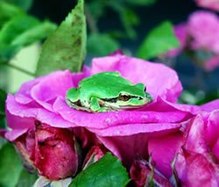|
A little frog brings a message of soil renewal last week. Jane, Warren and I began the task of taking apart the farm and putting it to bed for Winter. Midway through the drizzly Sunday afternoon, as I was emptying and bundling hose after hose, I suddenly noticed a little flicker of green dart through my peripheral vision. I stopped what I was doing and tried to focus my eyes where it had been. I could barely see him—he was camouflaged so well—but there on the stalk of one of our squash plants was a bright green frog. He was no bigger than 3 cm long, and had a little yellow-orange spot on his head the exact color of a wilting squash blossom.
Later that day Warren called me over to inspect a pile of eggs he had found! Underneath the protective foliage they were nestled into a little indentation in the earth, maybe 30 or so tiny, white, perfectly spherical eggs. After some deliberation we agreed they must belong to a reptile or amphibian: Probably another frog! As enchanting as this wildlife was to witness in person, it is also a great sign for the health of our farm! Amphibians are known to be very sensitive to their surroundings because they have a very thin, permeable skin that allows environmental toxins to easily enter their bodies. Consequently, the presence of frogs and salamanders can be taken as a sign that an area is more or less free from pollution. What an amazing compliment to our farm that a frog chose to make its home and lay its eggs amongst our plants! This is just one of many changes that we have seen in our mini-ecosystem over the course of the season. Back in Spring I remember looking out at fields of morning glory and hard, dry, clay soil and feeling a little daunted. But as we added organic matter to the soil, added food sources for pollinators, and created little habitats, we began to see an influx of worms, bees, butterflies, birds, and now frogs. Our weed diversity changed as well: what started off as a sea of pure bindweed is now a sea of bindweed with islands of clover, german chamomile, dandelion, dock, and lambsquarter (to name a few) speckled throughout the landscape. As a culture and as a farm, we still have a lot of work to do as we transition back to a food system that is sustainable for farmers, communities, and ecosystems. However, as we continue on this mission it’s important to savor the small victories: like watching a frog hop around your squash patch without a care in the world. Chloe Wood-Henrickson, First Light Farm staff farmer
2 Comments
Leave a Reply. |
Archives
March 2020
Categories |
Proudly powered by Weebly

 RSS Feed
RSS Feed